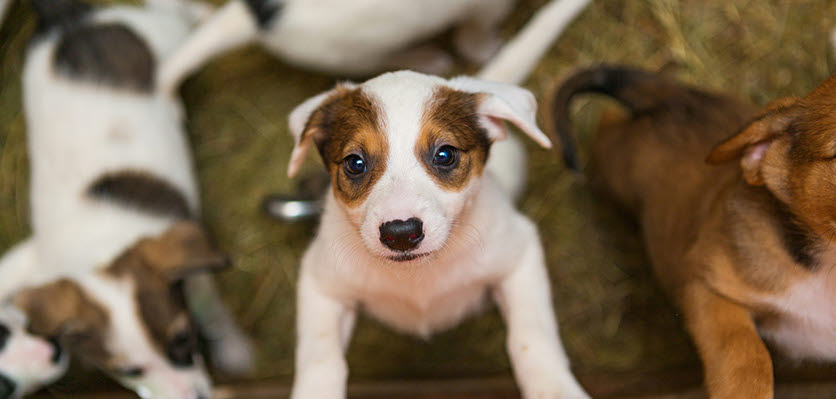Introducing a new pet to a household

Bringing a new pet home is very exciting. However, there can be some challenges, which are worth understanding to ensure a smooth transition for both you and your new pet. Understanding your new pet's background helps to prevent problems in the future. Introductions to existing pets in the home are a delicate matter. This change can be stressful for you, and your new and current pets. The following tips can help you with a relaxed and successful transition.
Understand their background
Understanding the background from which your new pet has come from is key to foreseeing and preventing any problems unfolding. It is important to understand the level of socialisation for both your new and current pets. Respect that bringing a new pet home can pose a threat to the resident pets, particularly in regard to territory, which may cause a degree of stress to an individual.
Bring home their blanket
When introducing a new cat, dog or puppy to the home, it is a good idea to bring home the scent of the new pet first. This can be done by bringing home a blanket that the new pet has been using or sleeping on. By introducing the smells of the new pet before actually meeting, you are not overwhelming either pet. You can then place this blanket in an area where the new pet will sleep.
Dogs
A neutral location is key for dogs
Bringing resident dogs and new dogs to a neutral territory unknown to both dogs is an excellent way to introduce them to each other. This minimises territorial behaviour and neutralises any sense of confinement./p>
As a precaution, dogs should be on a loose leash and handled independently. If you are relaxed or tense, dogs will sense this respectively, therefore your job is to remain calm and relaxed. If dogs are disinterested in each other, that is perfectly acceptable behaviour. Do not force interaction between dogs.
Praise positive interactions
Walk past each other, allowing both dogs to acknowledge one another, remaining upbeat and happy. This allows dogs to gradually get comfortable with each other and keeps the experience positive.
Move away and repeat allowing dogs to then sniff each other, encouraging and praising positive interactions between the dogs. This minimises the incidence of dogs becoming overwhelmed which can result in aggression escalating between the dogs.
Keeping the dogs focus on you is helpful. Commands and respective praise are a good tool to exercise in between introductions. This keeps dogs upbeat and happy.
Watch their body language
Be cautious and calmly move dogs away from each other if you see these behaviours:
- Raised hair on the back (hackles)
- Teeth bearing
- Growling
- Continued staring
Coming home
Like territory, dogs have priorities and prized possessions which dictate how they will behave. This depends on the individual, but food is a common prized possession. It is therefore recommended that removing all food bowls, toys, beds or anything that could resemble a prized possession of resident pets be removed upon introduction of the new pet to the home.
Baby gates can assist to set boundaries for the new dog during acclimation to the new home. Initially, have resident pets in another area of the home while the new dog is taken around the room he will stay in. This allows him to focus on the new environment rather than worrying about the direct presence of other animals, they will hear them and smell them. Feed animals separately and exercise baby gates, particularly when unsupervised.
Supervision is vital as play can quickly escalate into unwanted overexcitement and aggression. Calmly separate dogs for a few minutes when play escalates to growls or an unbalanced dynamic. Praise them when they are playing well together.
Cats
Many of the same rules apply to cats. Initial separation and confinement to given spaces in the home is helpful. Bringing smells home to existing cats serves the same purpose of a slow introduction as not to overwhelm.
Cats are territorial
Cats can be extremely territorial and do not adjust to change quite as quickly as dogs. Time is what it takes for a new cat to settle into a new home, particularly with existing pets. Confining cats for a week in their new home is a good idea. This helps cats to understand and become comfortable with their new surroundings, just like dogs.
Freedom
After the first week, you may slowly introduce the cat to different parts of the house allowing supervised time in new rooms. They will become more confident with time and eventually earn their freedom to roam all over their new house. If there are other cats in the home, eating separately and ensuring clean separate litter trays is essential.
Go high
Ensure cats always have an escape route from each other. Cats will often prefer to be high up, particularly if a dog is in the home.
Watch their body language
Be cautious and calmly move away from your cat to allow her to settle if you see these behaviours:
- Flattened ears
- Wide eyes with fully dilated pupils
- Hissing and spitting
- Tail slashing
If these behaviours persist regularly, you should consult with your veterinarian.
Be patient
As with all new relationships, it takes time for all animals to establish new trusting relationships with one another, and with you. Adopting some of the above strategies may alleviate stress-inducing triggers. Remember, the goal is to cultivate a dynamic in your home where animals are comfortable and relaxed with you and each other.
